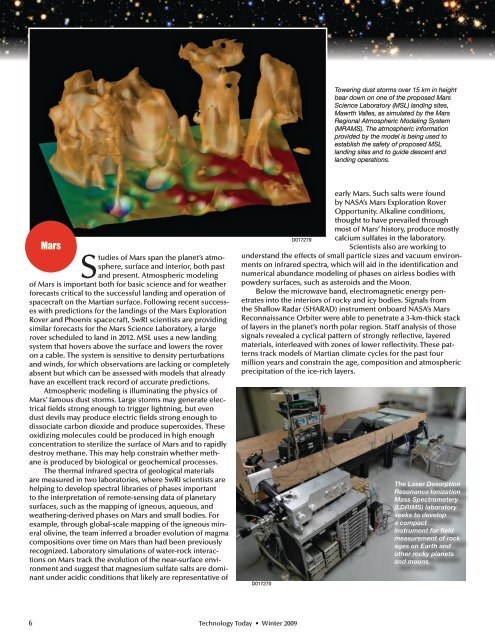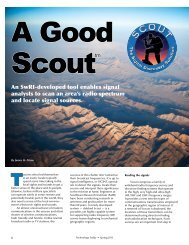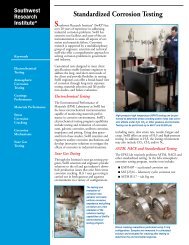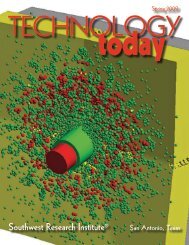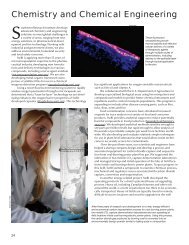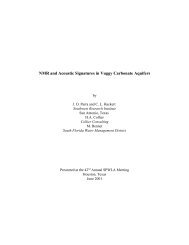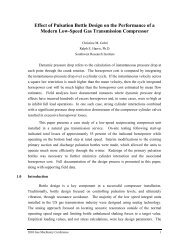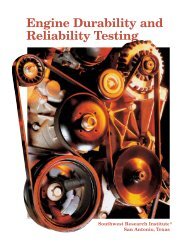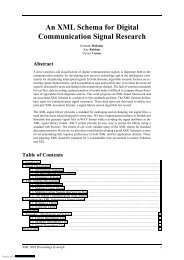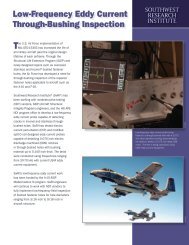Technology Today - Southwest Research Institute
Technology Today - Southwest Research Institute
Technology Today - Southwest Research Institute
You also want an ePaper? Increase the reach of your titles
YUMPU automatically turns print PDFs into web optimized ePapers that Google loves.
Towering dust storms over 15 km in height<br />
bear down on one of the proposed Mars<br />
Science Laboratory (MSL) landing sites,<br />
Mawrth Valles, as simulated by the Mars<br />
Regional Atmospheric Modeling System<br />
(MRAMS). The atmospheric information<br />
provided by the model is being used to<br />
establish the safety of proposed MSL<br />
landing sites and to guide descent and<br />
landing operations.<br />
Mars<br />
Studies of Mars span the planet’s atmosphere,<br />
surface and interior, both past<br />
and present. Atmospheric modeling<br />
of Mars is important both for basic science and for weather<br />
forecasts critical to the successful landing and operation of<br />
spacecraft on the Martian surface. Following recent successes<br />
with predictions for the landings of the Mars Exploration<br />
Rover and Phoenix spacecraft, SwRI scientists are providing<br />
similar forecasts for the Mars Science Laboratory, a large<br />
rover scheduled to land in 2012. MSL uses a new landing<br />
system that hovers above the surface and lowers the rover<br />
on a cable. The system is sensitive to density perturbations<br />
and winds, for which observations are lacking or completely<br />
absent but which can be assessed with models that already<br />
have an excellent track record of accurate predictions.<br />
Atmospheric modeling is illuminating the physics of<br />
Mars’ famous dust storms. Large storms may generate electrical<br />
fields strong enough to trigger lightning, but even<br />
dust devils may produce electric fields strong enough to<br />
dissociate carbon dioxide and produce superoxides. These<br />
oxidizing molecules could be produced in high enough<br />
concentration to sterilize the surface of Mars and to rapidly<br />
destroy methane. This may help constrain whether methane<br />
is produced by biological or geochemical processes.<br />
The thermal infrared spectra of geological materials<br />
are measured in two laboratories, where SwRI scientists are<br />
helping to develop spectral libraries of phases important<br />
to the interpretation of remote-sensing data of planetary<br />
surfaces, such as the mapping of igneous, aqueous, and<br />
weathering-derived phases on Mars and small bodies. For<br />
example, through global-scale mapping of the igneous mineral<br />
olivine, the team inferred a broader evolution of magma<br />
compositions over time on Mars than had been previously<br />
recognized. Laboratory simulations of water-rock interactions<br />
on Mars track the evolution of the near-surface environment<br />
and suggest that magnesium sulfate salts are dominant<br />
under acidic conditions that likely are representative of<br />
early Mars. Such salts were found<br />
by NASA’s Mars Exploration Rover<br />
Opportunity. Alkaline conditions,<br />
thought to have prevailed through<br />
most of Mars’ history, produce mostly<br />
D017279 calcium sulfates in the laboratory.<br />
Scientists also are working to<br />
understand the effects of small particle sizes and vacuum environments<br />
on infrared spectra, which will aid in the identification and<br />
numerical abundance modeling of phases on airless bodies with<br />
powdery surfaces, such as asteroids and the Moon.<br />
Below the microwave band, electromagnetic energy penetrates<br />
into the interiors of rocky and icy bodies. Signals from<br />
the Shallow Radar (SHARAD) instrument onboard NASA’s Mars<br />
Reconnaissance Orbiter were able to penetrate a 3-km-thick stack<br />
of layers in the planet’s north polar region. Staff analysis of those<br />
signals revealed a cyclical pattern of strongly reflective, layered<br />
materials, interleaved with zones of lower reflectivity. These patterns<br />
track models of Martian climate cycles for the past four<br />
million years and constrain the age, composition and atmospheric<br />
precipitation of the ice-rich layers.<br />
D017270<br />
The Laser Desorption<br />
Resonance Ionization<br />
Mass Spectrometery<br />
(LDRIMS) laboratory<br />
seeks to develop<br />
a compact<br />
instrument for field<br />
measurement of rock<br />
ages on Earth and<br />
other rocky planets<br />
and moons.<br />
6<br />
<strong>Technology</strong> <strong>Today</strong> • Winter 2009


